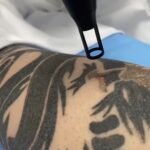Tattoo removal has become an increasingly popular procedure, allowing individuals to erase unwanted ink and start fresh. However, one of the most common concerns for those considering tattoo removal is the possibility of scarring. While modern technology has significantly reduced the risk of scars, certain factors still influence the chances of scarring. In this article, we’ll explore what the chances are of scarring after tattoo removal, the factors that contribute to it, and how to minimize the risk.
Table of Contents
ToggleUnderstanding Tattoo Removal Techniques
The risk of scarring largely depends on the method used for tattoo removal. Here’s a breakdown of the most common approaches:
- Laser Tattoo Removal
Laser technology, particularly Q-switched and picosecond lasers, is the most advanced and widely used method for tattoo removal. These lasers work by breaking down the tattoo ink particles into smaller fragments, allowing the body’s immune system to naturally eliminate them over time.- Scarring Risk: Minimal when performed by a trained professional. However, improper use of the laser or inadequate aftercare can lead to scarring.
- Dermabrasion
This older method involves physically sanding the skin to remove tattooed layers.- Scarring Risk: High compared to laser removal. The procedure is invasive and often results in texture changes or scars.
- Surgical Excision
This method involves cutting out the tattooed skin and stitching the area back together. It’s typically used for small tattoos.- Scarring Risk: Inevitable, as the procedure leaves a surgical scar.
Factors That Influence the Chances of Scarring
Several factors determine whether a person will experience scarring after tattoo removal. These include:
- Skin Type and Healing Ability
Individuals with darker skin tones or sensitive skin are more prone to pigmentation changes or keloid scars. Similarly, those with poor wound healing due to conditions like diabetes may face higher risks. - Tattoo Characteristics
- Size and Depth: Larger or deeply embedded tattoos require more sessions, increasing the likelihood of skin irritation and scarring.
- Ink Colors: Some colors, like green and blue, are more challenging to remove and may require more aggressive treatments.
- Experience of the Practitioner
The expertise of the technician or dermatologist is crucial. An experienced professional can calibrate the laser settings to suit your skin and tattoo type, reducing the risk of burns or scars. - Aftercare Practices
Proper aftercare is essential to avoid complications. Neglecting to follow post-procedure guidelines can lead to infections, which may result in scarring.
How to Minimize the Risk of Scarring
- Choose a Qualified Professional
Always seek out licensed and experienced dermatologists or certified laser technicians. Avoid unregulated clinics offering low-cost procedures, as improper equipment use increases the risk of damage. - Follow Aftercare Instructions
- Keep the treated area clean and moisturized.
- Avoid direct sunlight, as UV exposure can worsen skin irritation.
- Refrain from picking at scabs or blisters, as this can lead to permanent scars.
- Space Out Treatment Sessions
Allowing adequate time for healing between sessions helps prevent excessive skin trauma. - Consider Your Skin Type
Consult with a dermatologist to assess your skin’s reaction to laser treatments and discuss any pre-existing conditions that may affect healing.
When Scarring Is Likely
While modern tattoo removal methods minimize scarring, it’s important to note that some individuals may still experience mild scarring. This can occur if:
- The tattoo is old or deeply embedded.
- The removal process is rushed or improperly executed.
- The skin experiences severe blistering or burns during or after treatment.
The Bottom Line
The chances of scarring after tattoo removal are generally low with modern laser technology, but they aren’t zero. By understanding the factors that contribute to scarring and taking precautions, you can significantly reduce the risk. Choosing the right professional, committing to aftercare, and being patient throughout the process are key to achieving the best results with minimal complications.
If you’re considering tattoo removal, consult a trusted dermatologist to discuss your options and ensure a safe, effective procedure. Remember, a little extra care can go a long way in preserving your skin’s health and appearance.
Would you like assistance refining this further or adding specific case studies or testimonials?
For more detailed info about matching tattoos, please visit tattooculturecollective.com.



